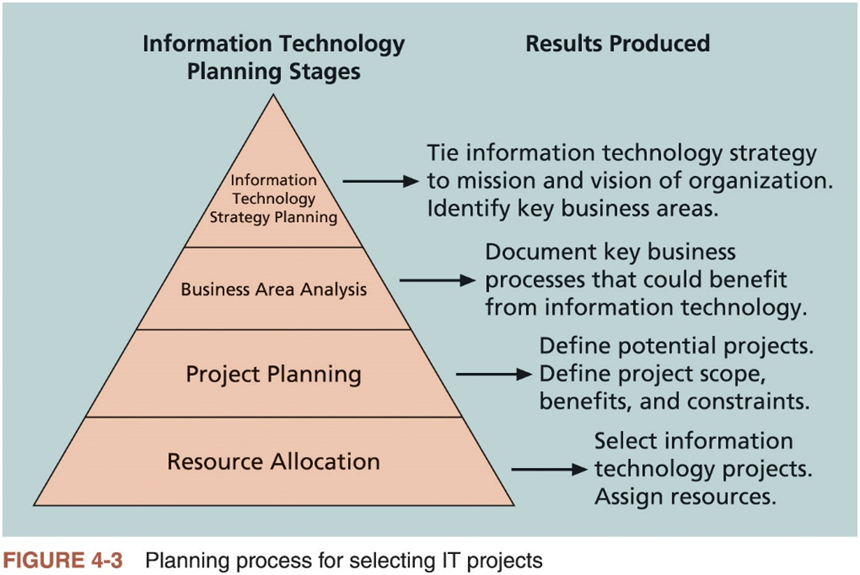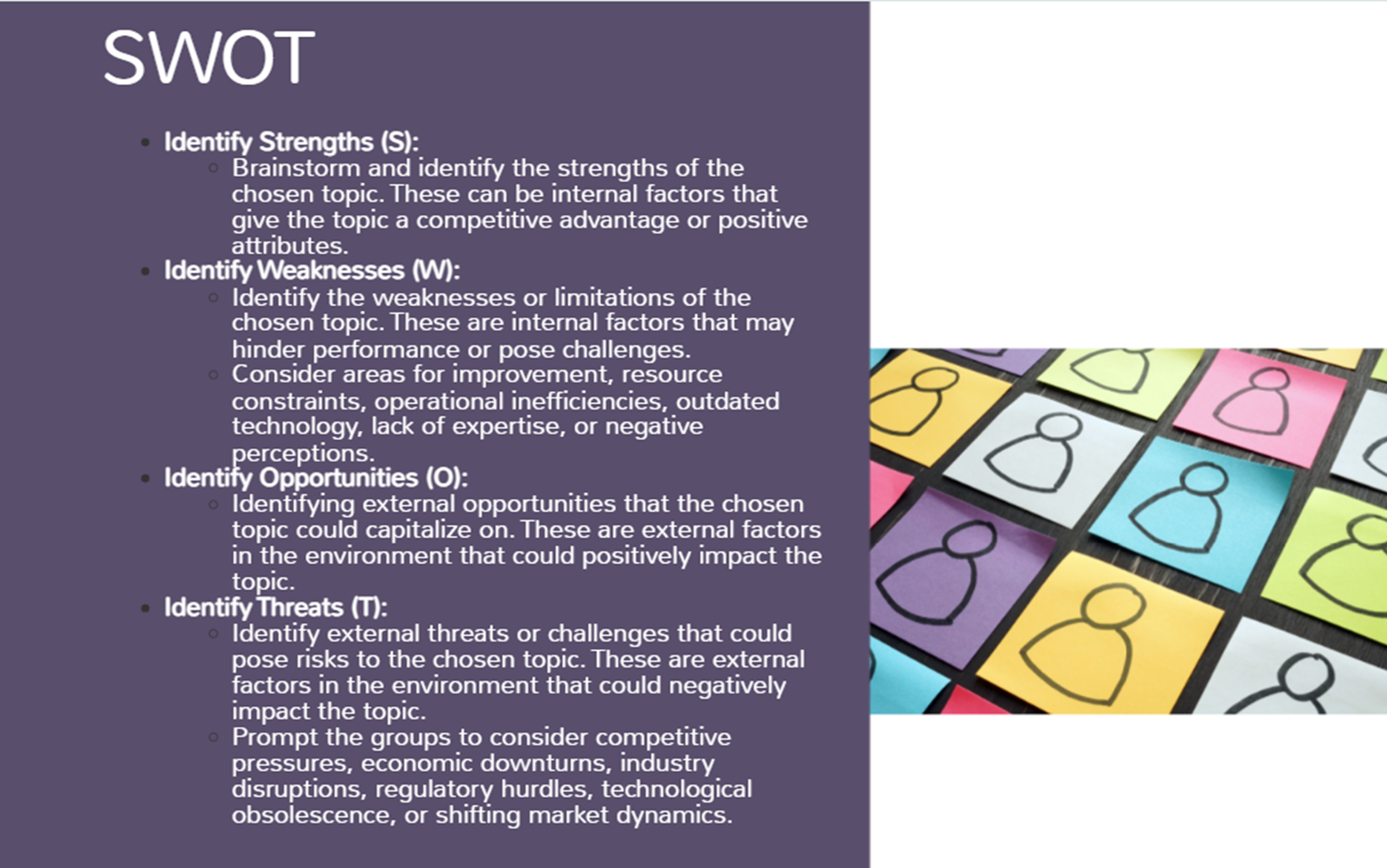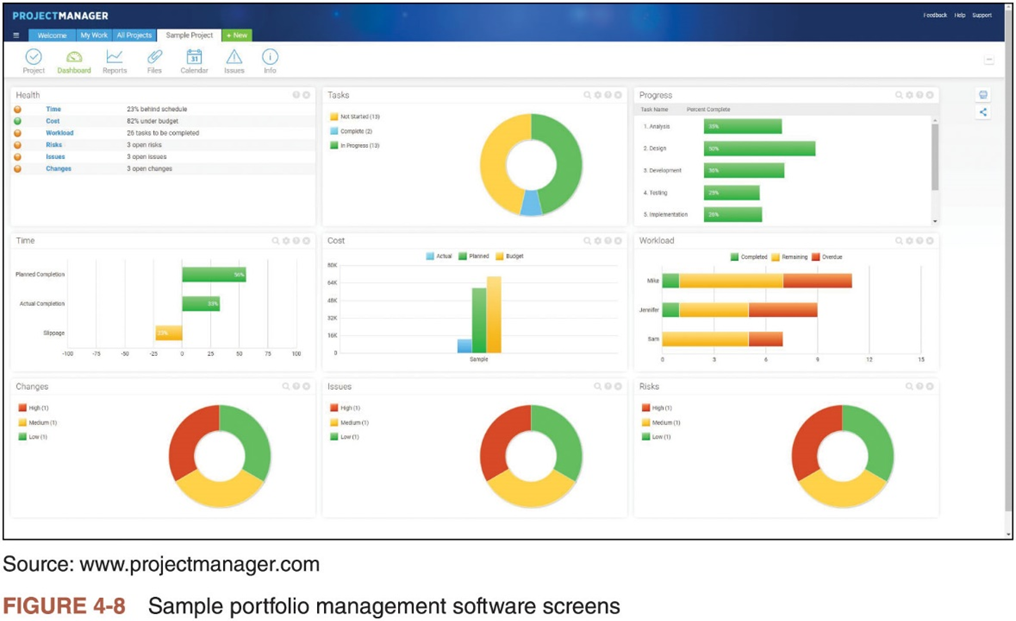Ch 4 PM Project Integration Management
1/24
Earn XP
Description and Tags
week 6 oct. 2 - do not need to stress abt this chapter
Name | Mastery | Learn | Test | Matching | Spaced |
|---|
No study sessions yet.
25 Terms
Project Managers must coordinate…
all of the other knowledge areas throughout a project’s life cycle
new PM’s tend to only focus on on the small details, they don’t focus on the big picture. That’s how the project gets held up.
What are the main processes of Project Integration Management?
developing the project charter, developing the project management plan, directing and managing project work, managing project knowledge, monitoring and change control, closing the project or phrase
Strategic planning
•Strategic planning involves determining long-term objectives
•Analyzing the strengths and weaknesses of an organization
•Studying opportunities and threats in the business environment
•Predicting future trends
•Projecting the need for new products and services
•SWOT analysis
•Analyzing Strengths, Weaknesses, Opportunities, and Threats
•Identifying potential projects
•Start of project initiation
•There’s no bad ideas in projects, bcs you never know what will work and what won’t
•Aligning IT with business strategy
•Organization must develop a strategy for using IT to define how it will support the organization’s objectives
Planning process for selection IT projects

Methods for Selecting Projects
Potential projects must be narrowed down
Methods for selecting projects
Focusing on broad organizational needs
Categorizing information technology projects
Performing net present value or other financial analyses
Using a weighted scoring model
Implementing a balanced scorecard
Categorizing IT Projects
Categorizations
Respond to a problem, opportunity, or directive
How long it will take to complete a project and what is the deadline for completion
Overall priority of the project
SWOT

Performing Financial Analyses
Financial considerations are often an important consideration in selecting projects
Regardless of current economics
Primary methods for determining the projected financial value of projects
Net present value (NPV) analysis
Return on investment (ROI)
Payback analysis
NPV Analysis
Method of calculating the expected net monetary gain or loss from a project by discounting all expected future cash inflows and outflows to the present point in time
projects with a positive NPV should be considered if financial value is a key criterion
projects with high NPVs are preffered
Payback Analysis
Payback period is the amount of time it will take to recoup, in the form of net cash inflows, the total dollars invested in a project
Determines how much time will elapse before accrued benefits overtake accrued and continuing costs
Payback occurs when the net cumulative discounted benefits equals the costs
Many organizations have requirements for the length of the payback period of an investment
Using a Weighted Scoring Model
Provides a systematic process for selecting projects based on many criteria
Identify criteria important to the project selection process
Assign weights (percentages) to each criterion so they add up to 100%
Assign scores to each criterion for each project
Multiply the scores by the weights and get the total weighted scores
A decision making model that helps you work through the factors and decide which of those factors are most important to you.
Implementing a Balanced Scorecard
Drs. Robert Kaplan and David Norton developed this approach to help select and manage projects that align with business strategy
A balanced scorecard is a strategic planning and management system that helps organizations align business activities to strategy, improve communications, and monitor performance against strategic goals
Developing a Project Charter
After deciding what project to work on, it is important to let the rest of the organization know
A project charter is a document that formally recognizes the existence of a project and provides direction on the project’s objectives and management
Key project stakeholders should sign a project charter to acknowledge agreement on the need and intent of the project
A project charter is a key output of the initiation process
Inputs for developing a project charter
Business case
Benefits management plan
Agreements
Enterprise environmental factors
Organizational process assets
Developing a Project Management Plan
Document used to coordinate all project planning documents and help guide a project’s execution and control
Plans created in the other knowledge areas are subsidiary parts of the overall project management plan
Common elements of a project management plan
Introduction/overview of the project
Description of how the project is organized
Management and technical processes used on the project
Work to be performed (scope)
Schedule and budget information
References to other project planning documents
Directing and Managing Project Work
Involves managing and performing the work described in the project management plan
The majority of time and money is usually spent on execution
The application area of the project directly affects project execution
Products of the project are produced during the execution phase
The project manager needs to focus on leading the project team and managing stakeholder relationships to execute the project management plan successfully
Project resource management, communications management, and stakeholder management are crucial to a project’s success
Providing Strong Leadership and a Supportive Culture
Project managers must lead by example
Demonstrate the importance of creating and then following good project plans and following them in project execution
Organizational culture can help project execution
Providing guidelines and templates
Tracking performance based on plans
Project managers may still need to break the rules to meet project goals
Senior managers must support those actions
Project Execution Tools and Techniques
Project managers can use specific tools and techniques to perform activities that are part of execution processes to complete task efficiently and effectively
Expert judgment
Meetings
Project management information systems
Managing Project Knowledge
Basic types of knowledge
Explicit knowledge: easily explained using words, pictures, or numbers and is easy to communicate, store, and distribute
Tacit knowledge: difficult to express and highly personal
Knowledge management should be done before, during, and after projects are completed
Often very difficult to accomplish
Monitoring and Controlling Project Work
Changes are inevitable on most projects, so it’s important to develop and follow a process to monitor and control changes
Monitoring project work includes collecting, measuring, and disseminating performance information
The project management plan provides the baseline for identifying and controlling project changes
A baseline is a starting point, a measurement, or an observation that is documented so that it can be used for future comparison.
Monitoring and Controlling Project Work
Corrective actions - result in improvement in project performance
Preventive change - reduce probability of negative consequences associated with project risk
Defect repair - bring defective deliverable into conformance with requirements
Performing Integrated Change Control
Identify, evaluate, and manage changes throughout project lifestyle.
Main objectives
Influencing the factors that create changes to ensure that changes are beneficial
Determining that a change has occurred
Managing actual changes as they occur
Change Control System
Formal, documented process that describes when and how official project documents and work may be changed
Describes who is authorized to make changes, paperwork required for these changes, and any automated or manual tracking systems the project will use
Change control board (CCB) is a formal group of people responsible for approving or rejecting changes on a project
Provide guidelines for preparing change requests, evaluate change requests, and manage the implementation of approved changes
Some CCBs only meet occasionally, so it may take too long for changes to occur
Some organizations have policies in place for time-sensitive changes
Closing Projects or Phases
To close a project or phase, you must finalize all activities and transfer the completed or cancelled work to the appropriate people
Main inputs are the project charter, project management plan, project documents, accepted deliverables, business documents, agreements, procurement documentation, and organizational process assets
Main tools and techniques are expert judgment, data analysis, and meetings
Using Software to Assist in Project Integration Management
Several types of software can be used to assist in project integration management
Documents can be created with word processing software
Presentations are created with presentation software
Tracking can be done with spreadsheets or databases
Communication software can facilitate communications
Project management software can pull everything together and show detailed and summarized information
Sample portfolio management software screens
